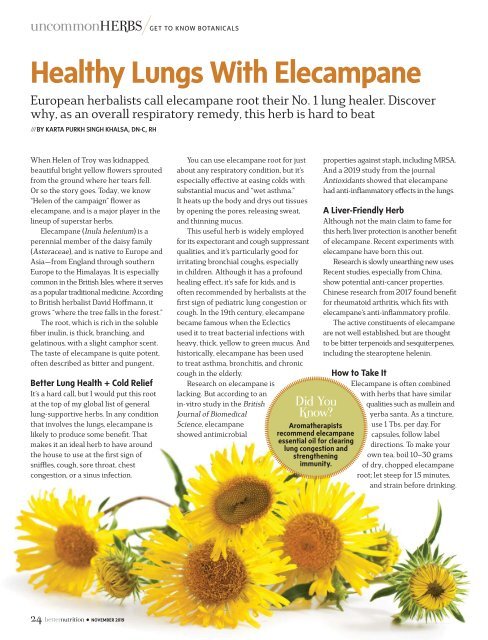You also want an ePaper? Increase the reach of your titles
YUMPU automatically turns print PDFs into web optimized ePapers that Google loves.
uncommonHERBS/GET TO KNOW BOTANICALS<br />
Healthy Lungs With Elecampane<br />
European herbalists call elecampane root their No. 1 lung healer. Discover<br />
why, as an overall respiratory remedy, this herb is hard to beat<br />
/// BY KARTA PURKH SINGH KHALSA, DN-C, RH<br />
When Helen of Troy was kidnapped,<br />
beautiful bright yellow flowers sprouted<br />
from the ground where her tears fell.<br />
Or so the story goes. Today, we know<br />
“Helen of the campaign” flower as<br />
elecampane, and is a major player in the<br />
lineup of superstar herbs.<br />
Elecampane (Inula helenium) is a<br />
perennial member of the daisy family<br />
(Asteraceae), and is native to Europe and<br />
Asia—from England through southern<br />
Europe to the Himalayas. It is especially<br />
common in the British Isles, where it serves<br />
as a popular traditional medicine. According<br />
to British herbalist David Hoffmann, it<br />
grows “where the tree falls in the forest.”<br />
The root, which is rich in the soluble<br />
fiber inulin, is thick, branching, and<br />
gelatinous, with a slight camphor scent.<br />
The taste of elecampane is quite potent,<br />
often described as bitter and pungent.<br />
<strong>Better</strong> Lung Health + Cold Relief<br />
It’s a hard call, but I would put this root<br />
at the top of my global list of general<br />
lung-supportive herbs. In any condition<br />
that involves the lungs, elecampane is<br />
likely to produce some benefit. That<br />
makes it an ideal herb to have around<br />
the house to use at the first sign of<br />
sniffles, cough, sore throat, chest<br />
congestion, or a sinus infection.<br />
You can use elecampane root for just<br />
about any respiratory condition, but it’s<br />
especially effective at easing colds with<br />
substantial mucus and “wet asthma.”<br />
It heats up the body and drys out tissues<br />
by opening the pores, releasing sweat,<br />
and thinning mucus.<br />
This useful herb is widely employed<br />
for its expectorant and cough suppressant<br />
qualities, and it’s particularly good for<br />
irritating bronchial coughs, especially<br />
in children. Although it has a profound<br />
healing effect, it’s safe for kids, and is<br />
often recommended by herbalists at the<br />
first sign of pediatric lung congestion or<br />
cough. In the 19th century, elecampane<br />
became famous when the Eclectics<br />
used it to treat bacterial infections with<br />
heavy, thick, yellow to green mucus. And<br />
historically, elecampane has been used<br />
to treat asthma, bronchitis, and chronic<br />
cough in the elderly.<br />
Research on elecampane is<br />
lacking. But according to an<br />
in-vitro study in the British<br />
Journal of Biomedical<br />
Science, elecampane<br />
showed antimicrobial<br />
Did You<br />
Know?<br />
Aromatherapists<br />
recommend elecampane<br />
essential oil for clearing<br />
lung congestion and<br />
strengthening<br />
immunity.<br />
properties against staph, including MRSA.<br />
And a <strong>2019</strong> study from the journal<br />
Antioxidants showed that elecampane<br />
had anti-inflammatory effects in the lungs.<br />
A Liver-Friendly Herb<br />
Although not the main claim to fame for<br />
this herb, liver protection is another benefit<br />
of elecampane. Recent experiments with<br />
elecampane have born this out.<br />
Research is slowly unearthing new uses.<br />
Recent studies, especially from China,<br />
show potential anti-cancer properties.<br />
Chinese research from 2017 found benefit<br />
for rheumatoid arthritis, which fits with<br />
elecampane’s anti-inflammatory profile.<br />
The active constituents of elecampane<br />
are not well established, but are thought<br />
to be bitter terpenoids and sesquiterpenes,<br />
including the stearoptene helenin.<br />
How to Take It<br />
Elecampane is often combined<br />
with herbs that have similar<br />
qualities such as mullein and<br />
yerba santa. As a tincture,<br />
use 1 Tbs. per day. For<br />
capsules, follow label<br />
directions. To make your<br />
own tea, boil 10–30 grams<br />
of dry, chopped elecampane<br />
root; let steep for 15 minutes,<br />
and strain before drinking.<br />
24 • NOVEMBER <strong>2019</strong>

















